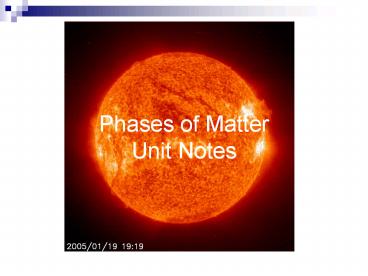Phases of Matter Unit Notes - PowerPoint PPT Presentation
Title:
Phases of Matter Unit Notes
Description:
Phases of Matter Unit Notes HEAT Heat is one form of ENERGY. It is sometimes called THERMAL ENERGY. Other forms of energy include: Light Sound Nuclear Kinetic (energy ... – PowerPoint PPT presentation
Number of Views:106
Avg rating:3.0/5.0
Title: Phases of Matter Unit Notes
1
Phases of MatterUnit Notes
2
HEAT
- Heat is one form of ENERGY. It is sometimes
called THERMAL ENERGY. - Other forms of energy include
- Light
- Sound
- Nuclear
- Kinetic (energy of motion)
- Potential (stored energy)
3
Heat is...
- A measure of how much kinetic energy matter has
- Particles with high heat are moving at a HIGH
average speed - Particles with low heat are moving at a LOW
average speed
4
Heat Transfer
- When we talk about the transfer of heat, we are
really talking about transferring KINETIC ENERGY
among particles. - Heat always moves from the HOTTER object to the
COOLER object.
5
Heat and the Motion of Particles
- When we add heat (energy to particles), it does
WHAT to their motion?
- Heat increases the motion and energy level of the
particles - Heating water animation
- http//mutuslab.cs.uwindsor.ca/schurko/animations/
waterphases/status_water.htm
6
Phases of Matter
- There are three main phases of matter
- Solid
- Liquid
- Gas
GAS is the phase where particles have the most
energy
SOLID is the phase where particles have the least
energy
7
Phases of Matter Solid
- Particles have little motion/energy they are
packed/joined together tightly - Particles are very organized
- Do NOT move to fit the shape of their container
and do not fill the container (they keep their
original shape) - It is hard to compress or
- change the shape of a solid
8
Phases of Matter Liquid
- Particles have more motion/energy joined
together more loosely - Particles WILL take on the shape of their
container but will not fill it entirely - Molecules of a liquid like
- to stick together. Liquids
- are hard to compress.
9
Phases of Matter Gases
- Particles have a great deal of energy and do not
stick together closely they bounce around a lot! - WILL spread out to fill entire container and fit
the shape of the container they are in - Gasesvapor
- Gases are easily
- compressed
10
Phases of Matter Plasma
- Similar to gases, but made up of ions and
electrons of an element - Examples Northern lights, neon lights, stars
- Require a special environment to exist
11
Phases of Matter
http//mutuslab.cs.uwindsor.ca/schurko/animations/
phasesofmatter/phasesofmatter.html
12
Phase Changes
- A phase change is when we change from one state
of matter to another - Example A solid changing to a liquid
13
Names for Phase Changes
- Solid to liquid MELTING
- Liquid to gas VAPORIZATION or BOILING or
EVAPORATION - Solid to gas SUBLIMATION
- Gas to liquid CONDENSATION
- Liquid to solid FREEZING
- Gas to solid DEPOSITION
14
Names for Phase Changes
15
Phase Changes
HIGH ENERGY GAS
MEDIUM ENERGY LIQUID
ADD ENERGY
REMOVE ENERGY
Low energy solid
16
Phase Changes
- To go to a state of matter involving MORE energy,
we must ADD energy. We can do this by HEATING the
substance. - Examples If we heat ice (solid), it will turn
into water (liquid), and will eventually boil and
turn into water vapor (gas)
17
Phase Changes
- To go to a state of matter involving LESS energy,
we must REMOVE energy. We can do this by COOLING
the substance. - Examples Water vapor (gas) from your hot shower
condenses on a cold mirror (liquid). If you leave
a window open, it might turn into ice droplets
(solid).
18
Phase Change Graphs
19
Phase Change Graphs
20
Phase Change Graphs
21
Check your understanding
- What are the three main states of matter?
- List these three states of matter from the state
with the LEAST amount of energy to the state with
the MOST energy - To go from a gas to a liquid, would you need to
ADD energy (heat) or RELEASE energy (cool)?
22
Melting Points and Boiling Points are Properties
of Matter
- We observed that water MELTS/FREEZES at 0 degrees
Celsius - We observed that water BOILS/CONDENSES at 100
degrees Celsius - Waters natural state at room temperature (25
degrees Celsius) is as a LIQUID
23
Different Substances will have Different Boiling
Points and Melting Points
Z Name Melting Point C Boiling Point C
1 Hydrogen -259.1 -252.9
2 Helium -272.2 -268.9
3 Lithium 180.5 1317
4 Beryllium 1278 2970
5 Boron 2300 2550
6 Carbon 3550 4827
7 Nitrogen -209.9 -195.8
8 Oxygen -218.4 -182.9
9 Fluorine -219.6 -188.1
10 Neon -248.7 -246.1
24
This results in different natural states at room
temperature.
- Name a substance that is a liquid at room
temperature. - What is the natural state of oxygen at room
temperature? - Can you name three substances that are solids as
their natural state? - If a substance has a boiling point of -100
degrees Celsius, what is its natural state at
room temperature?
25
Check your Understanding
- Why are melting points and boiling points
considered to be characteristic properties of
matter? - What other characteristic properties have we
learned about so far this year?






























